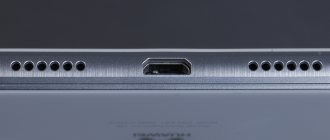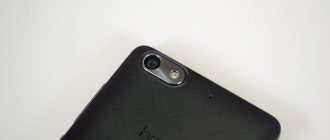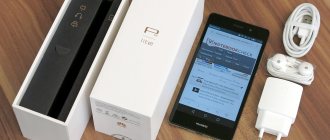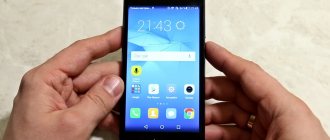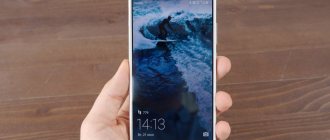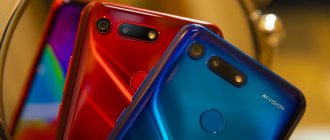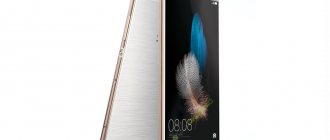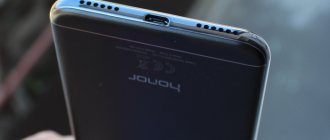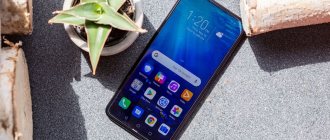Not long ago, I already published a review of Huawei P20 and P20 Pro; it remains to take a closer look at the Lite version, aimed at those who cannot afford a flagship, but still want to get a decent smartphone for the price. By the way, our model went on sale under the name Huawei P20 Lite, but in China it is known as Nova 3e. It is a common practice among manufacturers to give a different name to a device for sale in different markets. Of course, you shouldn’t expect a triple camera and similar bells and whistles from the lightweight version of the flagship, but nevertheless, it turned out to be very interesting and has become a worthy representative of the mid-price category.
A review of the Huawei P20 Lite smartphone shows that for its price it will be one of the best options for purchase, offering on board an average performance Kirin 659 processor, 4 + 64 GB of memory, the current version of the firmware with the EMUI 8.0 shell superimposed on top, dual main camera, as well as excellent battery life.
Specifications:
- Display: LTPS IPS, 5.84 inches, 2280×1080, 432 ppi, 2.5D glass
- Case: dimensions 148.6×71.2×7.4 mm, weight: 145 g
- Processor: HiSilicon Kirin 659, 64 bit, 16 nm, 4xARM Cortex-A53, 2.36 GHz, 4xARM Cortex-A53, 1.7 GHz, Mali-T830MP2 graphics accelerator
- RAM: 4 GB
- Flash memory: 64 GB + MicroSD (hybrid tray)
- Camera: Main: 16 megapixels (f/2.2, 1.0µm) + 2 MP, phase detection autofocus, LED flash, front: 16 MP (f/2.0, 1.12µm)
- Wireless technologies: Wi-Fi 802.11 a/b/g/n/ac 2.4+5 GHz, Bluetooth 4.2 LE (aptX, aptX HD), NFC
- Navigation: GPS, Glonass, BDS
- Battery: 3000 mAh, non-removable
- Operating system: Android 8.0 Oreo + EMUI 8.0
- Sim card: 2x nanoSIM
Design Huawei P20 Lite (Nova 3e)
Huawei P20 Lite 64 GB review makes it clear that in this regard, the smartphones of the new family are not much different from each other - each model is made of glass in combination with a metal side frame, which increases the strength characteristics of the structures. If you don’t look too closely, the Huawei P20 Light will be indistinguishable from its older brothers. However, the differences may not be that many, but they are there. Thus, the location of the fingerprint scanner has changed. This is both a plus and a minus at the same time, because on the front side it does not look so beautiful, but from the back it is not always convenient to use. For example, when the phone is lying on its back on the table.
As the review of the Huawei P20 Lite 64 GB smartphone showed, there are practically no frames on the sides of the display, but there are some on the top and bottom, albeit small ones. Due to this, the display occupies 80.5% of the entire front side. The top notch, borrowed from Apple, has not gone away. The only difference is that here it is much smaller and, if desired, you can hide it in the settings, getting an 18:9 ratio. If you hide it in the settings, the icons will be displayed on a dark background, which in my opinion is much more beautiful. A front camera, a speaker and the usual sensors were built into the recess. In the right corner there is a place for an LED event indicator, which will notify you with a bright flicker about a missed call or message.
Even more interesting: Rating of the most powerful smartphones
The location of the functional elements is no different from its older brothers and other Android phones. On the right side there is a power button and a rocker, with which you can control the volume level.
On the left there is a hybrid tray in which you can put one SIM card paired with microSD or two SIM cards. You are unlikely to use a flash drive, because 64 GB of internal memory is more than enough.
The Huawei P20 Lite midnight black review shows that the top edge is occupied by a microphone, which provides effective noise reduction when talking with a caller and recording voice on video.
At the bottom there is the main microphone, speaker, 3.5 mm headset jack and USB-C. By the way, this is an advantage of the younger model, since flagships do not have a headphone jack.
There are several color options for the Huawei P20 Lite case available for sale - pink, black, and also blue, which in my opinion looks the most beautiful and original. The front panel will be the same color. The backdrop shines beautifully when exposed to sunlight. But all this looks beautiful until you start using the phone. The body is made of glass, which makes it quite slippery and quickly collects fingerprints. Therefore, to keep your smartphone looking great, you have to constantly wipe it down.
Huawei P20 Lite blue full review shows that on the back side all the inscriptions are made in landscape orientation. The camera is also positioned vertically and rises significantly above the body, which is why I would recommend taking extra care to protect it. A case will perfectly cope with this task, which will also save the stylish case from scratches. Next to the dual camera, a flash and the Leica logo were installed - a company with which Huawei has been collaborating for a long time and very successfully in terms of cameras. This can be seen in the flagship P20 Pro, which currently tops the DxOMark rating.
Unlike flagships, the Huawei P20 Lite has a fingerprint scanner located on the back and I must say that it is convenient to use. It is installed slightly above the middle of the case, so that the finger clearly falls on it.
The smartphone has a 5.84-inch display, but despite this, the body itself does not seem large thanks to minimal frames. Personally, I find it convenient to operate it even with one hand. The only thing is that you need to be careful or immediately put on a case, because glass is a slippery material. In addition, its strength is significantly inferior to metal.
Review of the Honor 20 Lite smartphone
In a difficult period for itself, the Honor brand continues to saturate the market with models similar to each other with similar technical characteristics, while selecting for each of them some special “trick” so that the buyer can distinguish between them. Some models are distinguished by literally one or two characteristics. Thus, the fresh Honor 20 Lite smartphone being reviewed today is an almost exact copy of the Honor 20S, only with less RAM. However, a lower price and valuable gifts with purchase can turn a new product into a fairly attractive target for lovers of balanced purchases. We will find out whether the new model is worth such attention from a detailed review of the Honor 20 Lite smartphone.
Main characteristics of Honor 20 Lite (model MAR-LX1H)
- SoC Kirin 710, 8 cores: 4×Cortex-A73 @2.2 GHz + 4×Cortex-A53 @1.7 GHz
- GPU Mali-G51
- Operating system Android 9.0 (Pie) + Magic UI 2.1
- Touch display IPS 6.15″, 2312×1080 (19.5:9), 415 ppi
- Random access memory (RAM) 4 GB, internal memory 128 GB
- Support microSD (up to 512 GB), combined connector
- Nano-SIM support (2 pcs.)
- GSM/WCDMA networks
- LTE Cat.12 Band 1, 3, 4, 7, 8, 20, 38 networks
- GPS/A-GPS, Glonass, BDS
- Wi-Fi 802.11a/b/g/n/ac (2.4 and 5 GHz)
- Bluetooth 4.2, BLE, HWA
- NFC
- USB Type-C, USB OTG
- Audio output to headphones (3.5 mm)
- Main camera 48 MP (f/1.8) + 8 MP (f/2.4) + 2 MP (f/2.4); video [email protected] fps
- Front camera 24 MP, f/2.0
- Proximity and lighting sensors, magnetic field, gyroscope, accelerometer
- Fingerprint scanner (rear)
- Battery 3340 mAh
- Dimensions 153×73×7.4 mm
- Weight 159 g
| Retail offers | find out the price |
Appearance and ease of use
The Honor 20 Lite's body is distinguished by its elegance: it is a very thin and generally small smartphone by modern standards, easily fitting into any pocket. The device looks catchy and youthful thanks to its shiny glossy surfaces and bright gradient colors.
Both the back wall and the side frame are smooth, but the sides are not that slippery. However, all varnished surfaces quickly become covered with fingerprints, so the smartphone is nice, but requires a cleaning cloth.
The module with cameras protruding beyond the rear surface does not allow the device to lie stably on a hard surface; the smartphone sways when you touch the screen.
The fingerprint scanner is installed on the back side, it works quickly and accurately, although it is installed, perhaps, a little high - it could be lowered.
The front camera is placed here in a drop-shaped cutout, into which neither an additional module nor a flash fit. But above the camera in the area of the speaker grille you can see a very useful element that has suddenly become quite rare - an LED event indicator. This is good news.
The smartphone supports two Nano-SIM cards or one Nano-SIM and a microSD memory card, since the connector is hybrid. Hot swapping of cards is supported.
The card slot is located at the top end, next to the hole for the additional microphone. The metal side frame has a wider surface at the upper and lower ends, which looks impressive.
At the bottom end there is a USB Type-C connector, a speaker, a microphone and a 3.5 mm audio output. Thus, we can note the presence of two microphones in the device, and therefore the presence of a noise reduction system.
The hardware buttons on the side are smooth and tactilely indistinguishable from each other. The keys have a pleasant soft stroke.
Honor 20 Lite is offered in Russia in several colors: black, white, blue and purple. The last two have a gradient overflow. The smartphone body did not receive protection from dust and moisture.
Screen
Honor 20 Lite is equipped with an IPS display measuring 66x141 mm, diagonal - 6.15 inches, resolution - 2312x1080 (with an aspect ratio of 19.5:9), pixel density - 415 ppi. The frame around the screen has a width of 3 mm on the sides, 7 mm on the bottom, and 4 mm on the top.
The front surface of the screen is made in the form of a glass plate with a mirror-smooth surface that is scratch-resistant. Judging by the reflection of objects, the anti-glare properties of the screen are better than those of the Google Nexus 7 (2013) screen (hereinafter simply Nexus 7). For clarity, here is a photo in which a white surface is reflected in the switched off screens (on the left - Nexus 7, on the right - Honor 20 Lite, then they can be distinguished by size):
The screen of the Honor 20 Lite is noticeably darker (brightness according to photographs is 100 versus 116 for the Nexus 7). The ghosting of reflected objects in the Honor 20 Lite screen is very weak, this indicates that there is no air gap between the layers of the screen (more specifically, between the outer glass and the surface of the LCD matrix) (OGS - One Glass Solution type screen). Due to the smaller number of boundaries (glass/air type) with very different refractive indices, such screens look better in conditions of intense external illumination, but their repair in the case of cracked external glass is much more expensive, since the entire screen has to be replaced. The outer surface of the screen has a special oleophobic (grease-repellent) coating, which is significantly more effective than that of the Nexus 7, so fingerprints are removed much more easily and appear at a lower speed than with regular glass.
When displaying the white field in full screen and manually controlling the brightness, its maximum value was 480 cd/m² in normal conditions, and in very bright light it rises to 530 cd/m². The maximum brightness is very high, therefore, given the excellent anti-glare properties, screen readability even on a sunny day outdoors should be at a good level. The minimum brightness value is 1 cd/m². In complete darkness, the brightness can be reduced to a comfortable value. There is automatic brightness adjustment based on the light sensor (it is located to the right of the front speaker cutout on the upper edge of the front panel). In automatic mode, as external lighting conditions change, the screen brightness both increases and decreases. The operation of this function depends on the position of the brightness adjustment slider: with it the user can try to set the desired brightness level in the current conditions. If you do not interfere, then in complete darkness the auto-brightness function reduces the brightness to 4 cd/m² (a bit dark), in an office illuminated by artificial light (approximately 550 lux) it sets it to 160 cd/m² (normal), in a very bright environment (corresponds to clear lighting during the day outdoors, but without direct sunlight - 20,000 lux or a little more) increases to 530 cd/m² (which is what is needed). The backlight brightness level depends on the position of the slider in dark and average conditions, and in very bright environments it is always set to maximum. We weren't happy with the default result, so we moved the slider a little to the right in complete darkness and for the three conditions above, we got 13, 160 and 530 cd/m² (the perfect combination). It turns out that the auto-brightness function works adequately and allows the user to customize their work to individual requirements. At any brightness level, there is no significant backlight modulation, so there is no screen flicker.
This smartphone uses an IPS matrix. The microphotographs show a typical IPS subpixel structure:
For comparison, you can see the gallery of microphotographs of screens used in mobile technology.
The screen has good viewing angles without significant color shift even with large viewing deviations from perpendicular to the screen and without inverting shades. For comparison, here are photographs in which the same images are displayed on the screens of Honor 20 Lite and Nexus 7, while the screen brightness is initially set to approximately 200 cd/m², and the color balance on the camera is forcibly switched to 6500 K.
There is a white field perpendicular to the screens:
Note the good uniformity of brightness and color tone of the white field.
And a test picture:
The colors on the Honor 20 Lite's screen are clearly oversaturated, and the color balance varies between screens. Let us remind you that the photograph cannot serve as a reliable source of information about the quality of color rendering and is provided only for conditional visual illustration. The reason is that the spectral sensitivity of the camera sensor does not exactly match this characteristic of human vision.
Now at an angle of approximately 45 degrees to the plane and to the side of the screen:
It can be seen that the colors have not changed much on both screens, but on the Honor 20 Lite the contrast has decreased to a greater extent due to the greater brightening of blacks.
And a white field:
The brightness of the screens at an angle has decreased (at least 5 times, based on the difference in shutter speed), but the Honor 20 Lite's screen is still a little darker. When deviated diagonally, the black field brightens greatly and acquires a slightly pinkish tint. The photographs below demonstrate this (the brightness of the white areas in the direction perpendicular to the plane of the screens is the same!):
And from another angle:
When viewed perpendicularly, the uniformity of the black field is excellent:
The contrast (approximately in the center of the screen) is high - about 1000:1. The black-white-black response time is 20.5 ms (9.5 ms on + 11 ms off). The transition between halftones of gray 25% and 75% (based on the numerical value of the color) and back takes a total of 34 ms. The gamma curve, constructed using 32 points with equal intervals based on the numerical value of the shade of gray, did not reveal any blockage in either the highlights or the shadows. The exponent of the approximating power function is 2.10, which is lower than the standard value of 2.2. In this case, the real gamma curve noticeably deviates from the power-law dependence:
This is due to the fact that this device has a dynamic adjustment of the backlight brightness with an unobvious dependence on time and on the nature of the displayed image. As a result, the resulting dependence of brightness on hue (gamma curve) may not correspond to the gamma curve of a static image, since the measurements were carried out with sequential display of shades of gray on almost the entire screen. For this reason, we carried out a number of tests - determining contrast and response time, comparing black illumination at angles - (however, as always) when displaying special templates with a constant average brightness, and not monochromatic fields in the entire screen. In general, such non-disabled brightness correction does nothing but harm, since constantly changing the screen brightness can at least cause some discomfort.
The color gamut is wider than sRGB and almost equal to DCI:
Let's look at the spectra:
The spectra of the components are quite well separated, which determines the wide color gamut. For a consumer device, a wide color gamut is a disadvantage because it results in unnaturally saturated colors in images—drawings, photographs, and movies—that are oriented to the sRGB space (which is the vast majority of them). This is especially noticeable on recognizable shades, such as skin tones. The result is shown in the photographs above.
However, not everything is so bad: when you select the Normal , the coverage is compressed to the sRGB boundaries.
Colors in images become less saturated (and color balance changes slightly):
This device has the ability to adjust the color balance by adjusting the hue on the color wheel or simply by selecting one of three preset profiles.
The balance of shades on the gray scale after selecting the Normal profile is not ideal, since on most of the gray scale the color temperature is close to the standard 6500 K, but the deviation from the blackbody spectrum (ΔE) is about 10, which is considered not a very good indicator even for a consumer device . We tried to make an additional correction by moving the point on the circle to a position like in the photo above. In the graphs below, the Bright correspond to the results obtained after selecting the Bright , and the Normal + corr. curves. — data obtained after selecting the Normal and performing the correction. (The darkest areas of the gray scale can be ignored, since color balance there is not very important, and the error in measuring color characteristics at low brightness is large.)
After the correction it became a little better, as ΔE decreased.
There is a setting that allows you to reduce the intensity of the blue component.
Marketers tried to intimidate the user in order to show the level of care of the manufacturer. Of course, there is no UV radiation (see spectrum above), and there is no eye fatigue caused specifically by blue light. In principle, bright light can lead to disruption of the daily (circadian) rhythm. The bottom line is that in bright light, a person’s production of melatonin (a hormone that controls a person’s fatigue and need for sleep) is suppressed. But everything can be solved by adjusting the brightness to a comfortable level, and there is absolutely no point in distorting the color balance by reducing the contribution of blue.
To summarize: the screen has a very high maximum brightness (530 cd/m²) and has excellent anti-glare properties, so the device can be used outdoors without any problems, even on a sunny summer day. In complete darkness, the brightness can be reduced to a comfortable level (down to 1 cd/m²). It is also possible to use a mode with automatic brightness adjustment, which works adequately. Also, the advantages of the screen include an effective oleophobic coating, no air gap in the layers of the screen and no flickering, high contrast (1000:1), excellent uniformity of the black field, sRGB color gamut (if you choose the right profile). The disadvantages are the low stability of black to the deviation of the gaze from perpendicular to the screen plane. Taking into account the importance of characteristics for this particular class of devices, the quality of the screen can be considered high.
Cameras
The rear camera of the Honor 20 Lite consists of three modules. The main module with a 48 MP sensor (1/2″, 0.8 µm) and a lens with an f/1.8 aperture is complemented by a wide-angle module (120°) with an 8 MP sensor and a lens with an f/2.4 aperture, here at The smartphone films them. The third module (2 MP, f/2.4) does not take pictures; it provides measurement of the depth of field of the scene, which allows you to take portraits with background blur using the main module. There is fast phase detection (PDAF) autofocus and a single, but quite bright LED flash. There is no standard option to save pictures in RAW.
The main module, by default, shoots in a resolution of 12 megapixels, and not in the full 48 megapixels, since it uses “four pixels in one” technology. If you shoot in full resolution, the camera interface no longer offers the functions of zooming and automatically selecting settings using artificial intelligence. In principle, there is a gain in detail from shooting at 48 megapixels; it is clearly visible, for example, on bare branches of trees against the sky, but any small details also become better visible. In cases where this is important, we recommend switching to 48-megapixel photos.
12 MP, f/1.8 48 MP, f/1.8
12 MP, f/1.8 48 MP, f/1.8
12 MP, f/1.8 48 MP, f/1.8
How the night photo mode works in smartphones: testing the Honor 20S
In general, when shooting on the Honor 20 Lite, you can count on good quality images during the day. There is practically no noise in frames under such conditions, sharpness and detail are acceptable, exposure is adequate. It’s just that it’s not very clear with flowers: winter Moscow photographs do not give the opportunity to decide on this; summer is required.
Night shots in normal mode are weak, the smartphone has nothing to boast about here, but there is a night mode (taking one frame takes about 5 seconds).
The wide-angle module, of course, takes noticeably worse photos than the main one, but its very presence makes it possible to photograph large objects from a short distance, fitting everything into the frame.
8 MP, f/2.4
8 MP, f/2.4
8 MP, f/2.4
8 MP, f/2.4
Since there is no telephoto lens, there is no optical zoom. However, in the viewfinder of the camera application, however, in addition to the wide-angle icon that actually switches lenses, there is also a 2x zoom icon. Naturally, this will only be digital zoom.
zoom 2×
zoom 2× zoom 2×
zoom 2×
The maximum available digital zoom is 6x, with appropriate quality.
zoom 6×
There is no separate macro lens or at least such a shooting mode, but you can try using the main module with double zoom for this purpose. The result will look like this:
12 MP, f/1.8, 2× zoom
12 MP, f/1.8, 2× zoom
Video can be shot at a maximum resolution of 1080p at 60 fps without stabilization. There is no 4K shooting either. The video quality is average, both in terms of detail and sharpness. At night the camera records video poorly. The sound is recorded quite clearly, although some “deafness” - a limited frequency spectrum - clearly indicates a rather aggressive operation of the noise reduction system.
- Video #1 (94 MB, 1920× [email protected] fps, H.264, AAC)
- Video No. 2 (93 MB, 1920× [email protected] fps, H.264, AAC)
- Video No. 3 (77 MB, 1920× [email protected] fps, H.264, AAC)
The Honor 20 Lite's selfie camera uses a 24MP sensor and an f/2.0 aperture lens. The detail of the images here is not flagship, but the resolution margin is very large, so you can get excellent selfies during the day without any problems. The camera does a good job of conveying the full spectrum of highlights and shadows, leaving virtually no underexposed or overexposed areas. Modern programs do not yet know how to perfectly separate the central object from the background, but they have already learned how to decorate the background with various effects (hearts, circles, etc.), and it looks nice.
In addition, the developers did not limit themselves to technologies for optimizing selfie shots based on AI - they also created a special night selfie mode for limited lighting conditions. Of course, the detail here is very low; the image has to be reduced to the size and resolution of a smartphone screen. When shooting, the on-screen backlight, which acts as a flash, helps.
Telephone and communications
The Kirin 710 SoC, on which the Honor 20 Lite is based, includes a modem supporting LTE Cat.12/13 with a theoretical maximum download speed of up to 600 Mbps. The smartphone supports all the most common LTE FDD and TDD frequency bands in the Russian region: LTE FDD B1/B3/B4/B7/B8/B20 and TDD B38. In practice, within the city limits of the Moscow region, the device demonstrates reliable operation in wireless networks, does not lose connection, and quickly restores connection after a forced interruption. The Wi-Fi module supports both 2.4 and 5 GHz bands and 802.11ac mode. There is Bluetooth version 4.2, and there is also a fully functioning NFC module with support for contactless payment.
The phone application supports Smart Dial, that is, while dialing a phone number, a search is immediately carried out by the first letters in contacts. Each contact in the phone book can be assigned not only a unique ringtone, but also a video ringtone. Methods for sorting and displaying contacts are standard for the Android interface. The vibration alert feels very good in such a thin body. The cards operate in Dual SIM Dual Standby mode.
Software and multimedia
Honor 20 Lite uses Google Android OS version 9 with the proprietary Magic UI 2.1.0 shell as a software platform. This is the same EMUI, there are no obvious differences between them. The interface is familiar to us, more or less convenient, highly customizable, supports gestures, one-handed operation, and voice control. For those who like to clone social network accounts, there is such an opportunity. There are a number of special modes: gaming, productive, economical and even “in a case”. It is possible to unlock by face.
The smartphone does not have stereo speakers; the only loudspeaker sounds more or less clear, but the volume reserve is small. The sound is simple, mainly at high frequencies, but bright, clear, clear and more spacious than, say, the Honor 9X. The headphones sound good, the Histen audio effects system is supported, and there are presets for different types of headphones. There is an FM radio and a voice recorder with quite satisfactory sensitivity.
Performance
Honor 20 Lite runs on a single-chip Kirin 710 system, which is configured with two CPU clusters: four Cortex-A73 cores with a frequency of 2.2 GHz and four Cortex-A53 with a frequency of 1.7 GHz. The Mali-G51 GPU is responsible for graphics performance.
The amount of RAM is 4 GB, the storage capacity is 128 GB (of which about 108 GB is free). It supports installing a microSD memory card, as well as connecting external devices to the USB Type-C port in USB OTG mode.
Kirin 710 is not the latest and most productive SoC; it is made using a 12 nm process technology. In general, the Kirin 810 has long been prepared to replace it, but the Chinese are holding it back for the domestic market (in many ways, not of their own free will). The same Snapdragon 675 looks better in terms of results in AnTuTu and other benchmarks. However, there are no complaints about the responsiveness of the interface and the speed of applications, and for some games (the list of which is limited) there is even a graphics optimization technology - GPU Turbo 3.0. So, in general, you can play games: Modern Combat 3, Mortal Kombat X are going well, but Injustice 2 and PUBG are slowing down a bit.
Testing in comprehensive tests AnTuTu and GeekBench:
For convenience, we have compiled all the results we obtained when testing the smartphone in the latest versions of popular benchmarks into tables. The table usually adds several other devices from different segments, also tested on similar latest versions of benchmarks (this is done only for a visual assessment of the obtained dry figures). Unfortunately, within the framework of one comparison it is impossible to present the results from different versions of benchmarks, so many worthy and relevant models remain “behind the scenes” - due to the fact that they once passed the “obstacle course” on previous versions of test programs.
| Honor 20 Lite (HiSilicon Kirin 710) | Vsmart Live (Qualcomm Snapdragon 675) | Realme 5 pro (Qualcomm Snapdragon 712) | Redmi Note 8T (Qualcomm Snapdragon 665) | |
| AnTuTu (v8.x) (bigger is better) | 155993 | 208142 | 227198 | 174316 |
| GeekBench 5 (bigger is better) | 272/1171 | 506/1617 | 318/1485 | 308/1366 |
Testing the graphics subsystem in 3DMark and GFXBenchmark gaming tests:
| Honor 20 Lite (HiSilicon Kirin 710) | Vsmart Live (Qualcomm Snapdragon 675) | Realme 5 pro (Qualcomm Snapdragon 712) | Redmi Note 8T (Qualcomm Snapdragon 665) | |
| 3DMark Ice Storm Sling Shot ES 3.1 (bigger is better) | 763 | 980 | 2092 | 1073 |
| 3DMark Sling Shot Ex Vulkan (bigger is better) | 804 | 1075 | 1982 | 1039 |
| GFXBenchmark Manhattan ES 3.1 (Onscreen, fps) | 13 | 14 | 23 | 12 |
| GFXBenchmark Manhattan ES 3.1 (1080p Offscreen, fps) | 14 | 15 | 27 | 13 |
| GFXBenchmark T-Rex (Onscreen, fps) | 32 | 38 | 58 | 33 |
| GFXBenchmark T-Rex (1080p Offscreen, fps) | 34 | 41 | 75 | 36 |
Testing in browser cross-platform tests:
As for benchmarks for assessing the speed of the javascript engine, you should always make allowance for the fact that their results significantly depend on the browser in which they are launched, so the comparison can only be truly correct on the same OS and browsers, and this is possible during testing not always. For Android OS, we always try to use Google Chrome.
| Honor 20 Lite (HiSilicon Kirin 710) | Vsmart Live (Qualcomm Snapdragon 675) | Realme 5 pro (Qualcomm Snapdragon 712) | Redmi Note 8T (Qualcomm Snapdragon 665) | |
| Mozilla Kraken (ms, less is better) | 4247 | 2957 | 4103 | 4618 |
| Google Octane 2 (bigger is better) | 9525 | 16007 | 9963 | 7175 |
| JetStream (bigger is better) | 31 | 45 | 29 | 30 |
AndroBench memory speed test results:
Heat
Below is a thermal image of the rear surface obtained after 15 minutes of fighting with a gorilla in the game Injustice 2 (this test is also used to determine autonomy in 3D games):
Heating is greater at the top of the device, which apparently corresponds to the location of the SoC chip. According to the heat camera, the maximum heating was 44 degrees (at an ambient temperature of 24 degrees), which is higher than the average value in this test for modern smartphones.
Playing video
This device apparently does not support DisplayPort Alt Mode for USB Type-C - outputting image and sound to an external device when connected to a USB port. (Report from usbview.exe program.)
To test the output of video files on the screen of the device itself, we used a set of test files with an arrow and a rectangle moving one division per frame (see “Method for testing video playback and display devices. Version 1 (for mobile devices)”). Screenshots with a shutter speed of 1 s helped determine the nature of the output of frames of video files with various parameters: the resolution varied (1280 by 720 (720p), 1920 by 1080 (1080p) and 3840 by 2160 (4K) pixels) and frame rate (24, 25, 30, 50 and 60 fps). In the tests we used the MX Player video player in the “Hardware” mode. The test results are summarized in the table:
| File | Uniformity | Passes |
| 4K/60p (H.265) | cannot be played | |
| 4K/50p (H.265) | Fine | No |
| 4K/30p (H.265) | Great | No |
| 4K/25p (H.265) | Great | No |
| 4K/24p (H.265) | Great | No |
| 4K/30p | Great | No |
| 4K/25p | Great | No |
| 4K/24p | Fine | No |
| 1080/60p | Great | No |
| 1080/50p | Fine | No |
| 1080/30p | Great | No |
| 1080/25p | Fine | No |
| 1080/24p | Fine | No |
| 720/60p | Great | No |
| 720/50p | Great | No |
| 720/30p | Great | No |
| 720/25p | Great | No |
| 720/24p | Great | No |
Note: If both columns Uniformity and Skips have green ratings, this means that, most likely, when watching films, artifacts caused by uneven alternation and skipping of frames will either not be visible at all, or their number and visibility will not affect comfort viewing. Red marks indicate possible problems with playback of the corresponding files.
According to the frame output criterion, the quality of playback of video files on the screen of the smartphone itself is good, since in most cases frames (or groups of frames) can (but are not required) be output with uniform alternation of intervals and without skipping frames. When playing video files with a resolution of 1920 by 1080 pixels (1080p), the image of the video file itself is displayed one-to-one pixel by pixel, exactly at the height of the screen (in landscape orientation) and in true Full HD resolution. The brightness range displayed on the screen corresponds to the standard range of 16-235: all gradations of shades are displayed in shadows and highlights. Note that this smartphone does not support hardware decoding of H.265 files with a color depth of 10 bits per color.
Battery life
Honor 20 Lite sacrificed a capacious battery for a thin and light body. Accordingly, the device cannot boast of high autonomy, although the battery life is by no means a failure - it corresponds to the capabilities of the battery. In real life, the smartphone lasts until an evening charge, but it’s better not to count on more.
Testing has traditionally been carried out at the usual level of power consumption without using power saving functions, although the device has them.
| Battery capacity | Reading mode | Video mode | 3D Game Mode | |
| Honor 20 Lite | 3340 mAh | 15:00 | 11:00 am | 5:00 a.m. |
| Vsmart Live | 4000 mAh | 23:00 | 18:00 | 5:00 a.m. |
| realme 5 pro | 4035 mAh | 21:00 | 17:00 | 6:00 am |
| Redmi Note 8T | 4000 mAh | 21:00 | 15:30 | 5:00 a.m. |
Continuous reading in the FBReader program (with a standard, light theme) at a minimum comfortable brightness level (brightness was set to 100 cd/m²) lasted about 15 hours until the battery was completely discharged, and when continuously watching videos in high quality (720p) with the same brightness level via a home Wi-Fi network, the device operates for up to 11 hours. In 3D gaming mode, the smartphone can work for no more than 5 hours.
The smartphone is fully charged in 1 hour 50 minutes with a current of 2 A at a voltage of 9 V (18 W). Wireless charging is not supported.
Bottom line
Honor 20 Lite is already offered in official Russian retail. And not only the price itself is quite reasonable (15 thousand rubles), but also a smart bracelet Honor Band Running 4 is given as a gift when purchasing in the Honor brand store (at the time of the review; the set and selection of gifts changes from time to time), which makes an average smartphone in all respects a very attractive purchase. Especially for that kind of money.
Among the weaknesses of the Honor 20 Lite, we can only note the modest sound (but corresponding to the level of the model) and the platform of the previous generation. But at the same time, the smartphone has a good screen, quite high-quality shooting on the selfie camera (with a night selfie mode) and acceptable shooting on the main one, as well as extensive communication capabilities, including NFC support. And, of course, the ideal combination of ports: USB Type-C + 3.5 mm minijack.
Display Huawei P20 Lite
The screen is the strong point of the device, because even if you want to, there is nothing to complain about. We are offered a high-quality 5.84-inch IPS matrix with FullHD+ resolution (2280x1080) and a 19:9 ratio (if you remove the top notch in the settings, you get the standard 18:9). Not all applications support full-screen format yet, but more and more of them do. In addition, a review of the Huawei P20 Lite phone shows that the first time you turn on the application, you will be prompted to switch to full-screen mode, even if it is not optimized for working with it.
Even more interesting: Top 10 smartphones with the best battery life
Initially, the smartphone operates at FullHD+ resolution, but if desired, you can always switch to HD+ or activate the smart mode, in which the resolution is automatically selected to achieve better battery life results. When you hide your unibrow in the settings, a black bar appears at the top against which system icons will be displayed. At maximum resolution, the pixel density reaches 432 ppi, and there is no question of any graininess here. Huawei P20 Lite review in Russian introduces you to the fact that the display occupies 80.5% of the front panel area. The brightness reserve of 372 cd/m2 is enough, even in bright sun the picture remains readable.
There are also no problems with viewing angles - they are maximum.
In the settings you can change the color temperature to suit yourself, and there is a need for this, since out of the box the screen is prone to cold shades. This is not critical and fortunately you can change everything in the settings to suit yourself.
Frameless screen for fans of the classics
Compactness is a consequence of a small 6.15-inch display with thin frames by modern standards. The front camera fits into a neat cutout; its teardrop shape is reminiscent of the flagship HUAWEI P30 Pro.
The display will appeal to lovers of classics who do not accept the AMOLED fashion. The high-resolution 2312×1080 LPTS matrix installed here pleases with soft colors, excellent viewing angles and no flicker. The latter has a positive effect on eye comfort. Another plus in favor of the HONOR 20 Lite display is a wide range of brightness. The maximum level reaches the coveted 420 cd/m2, and the minimum level remains below 1 cd/m2. In the settings, you can adjust the color temperature and a special night mode.
Users should also pay attention to the LED indicator integrated into the speaker grille. This useful thing is becoming less and less common in smartphones, although knowing about notifications without turning on the screen is really convenient.
Performance of Huawei P20 Lite
The Huawei P20 Lite smartphone technical specifications are based on the average performance Kirin 659 processor, made on a 16-nm process technology. It includes 8 cores with a maximum frequency of 2.36 GHz. The Mali-T830MP2 video chip is responsible for the graphics. The RAM is 4 GB, but it is not made according to the newest LPDDR3 standard, which works a little slower than LPDDR4. User memory is 64 GB, which is already enough, but if necessary, you can add a microSD card. A full review and testing of the Huawei P20 Lite shows that we have already seen similar characteristics in the Nova 2, as well as the Mate 10 Lite.
Huawei P20 Lite test in Antutu
Thanks to this stuffing, the interface works quickly and stably, but in games everything is not so rosy. The fact is that Kirin processors and the Mali video accelerator are still noticeably inferior to smartphones built on Qualcomm processors in conjunction with the Adreno video chip. Despite this, most games run decently. Lags were encountered only in XCOM: Enemy Within, but in PUBG and NFS: No Limits the flight was excellent. There is face unlock and it works correctly.
Even more interesting: Top 7 Huawei smartphones of 2018-2019
Competitors
For less money, the Moto G7 Plus is available on the market - one of the best smartphones that can be purchased for an average of $200. There's fast charging, good cameras and a cool design, plus Moto pays a lot of attention to software, avoiding unnecessary programs that only harm optimization. Plus, the Moto G7 Plus will most likely receive an update to the latest version of Andoid 10 Q, but the Honor 20 Lite will most likely not be updated due to the termination of cooperation between Huawei and Google
Honor 10 Lite - released six months ago, it is very similar to the Honor 20 Lite, equipped with the same processor and a 6.21-inch IPS screen, but there is no wide-angle lens, and the shooting quality is generally worse. But Honor 10 Lite is cheaper, and this is its main advantage.
Samsung Galaxy A7 (2018) – you can get it for less money. It has an Amoled matrix with nominally infinite contrast, a wide-angle lens, but only 64 GB of memory and a less powerful processor. As for the quality of shooting on the main and wide-angle cameras, the Honor 20 Lite most likely wins here.
Redmi Note 7 will cost 2 times less, but it has the best Snapdragon 660 processor, a larger 4000 mAh battery + higher autonomy, QC 4.0 fast charging and a USB Type-C connector, a Quad-Bayer camera with a resolution of 48 MP.
The downside is that the RN7 does not have NFC or a wide-angle camera. Please rate the article:
Wireless communications
The Huawei P20 Light review showed that the smartphone received support for Wi-Fi 2.4 and 5 GHz, as well as an NFC chip, Bluetooth 4.2, support for aptX, aptX HD codecs, which provides better sound transmission in a wireless headset. They also retained the 3.5 mm audio jack, so you don’t have to throw away your old wired headset.
By the way, if we talk about sound, there is only one external speaker and is installed on the bottom edge. It doesn't sound the best for the device's price range. Watching a movie or playing will be fine, but if you are an avid music lover, then it will definitely not suit you.
Autonomy
The Huawei P20 Lite smartphone blue review proceeds to the test of its autonomy. Inside there is a built-in 3000 mAh battery with support for fast charging according to the Huawei SuperCharge standard. The technology only works if you use the included charger, but alas, the gadget arrived for my review without it. The battery life results are average, neither better nor worse than competitors. When tested in PCMark, a full charge lasted 6 hours and 19 minutes. and during actual use, the phone sits down on average after 5.5 hours of display activity. If you are an active user, then by the evening your smartphone is guaranteed to ask you to “eat”.
Huawei P20 Lite camera review
The camera is what we love most about Huawei smartphones. Of course, it won’t be as good in an affordable smartphone, but nevertheless, our expectations have never been higher. Huawei P20 Lite camera review showed that the main one includes a 16 MP sensor with f/2.2 aperture, as well as an additional one with a much more modest resolution of 2 MP. It does not affect the quality of pictures in any way and is used only to create the bokeh effect. The front camera has a resolution of 16 megapixels (f/2.0, pixel size is 1.12µm.
The quality of pictures on the Huawei P20 Lite is typical for its price category - during the day we get high-quality photos in which even small details are perfectly depicted, but at night it will be difficult to get a decent shot. Many photos come out blurry or too noisy. It's better to rely on manual settings, then you can get the most out of the camera.
When shooting with the main camera, you can get the Bokeh effect, but at the moment it works too aggressively. Sometimes the result is pleasing to the eye, but more often the algorithms make mistakes and blur the boundaries of the subject.
A review of the Huawei P20 Light camera shows that it is capable of shooting video only in FullHD quality. There is no electronic or optical stabilization, but this is a huge minus. In this regard, it is better to shoot in a stationary position, otherwise the picture will turn out to be twitching.
Huawei P20 Lite example slow motion video
Conclusion
Huawei P20 Lite is a standard representative of the mid-price category, which stands out for its good design, gorgeous display and decent cameras. Otherwise, there is simply nothing surprising about it; yes, it showed itself well in real use, but nothing more. If you need an option for music and games, then it is better to look towards Huawei flagships, for example P20, or choose a smartphone among competitors on Snapdragon, the same Xiaomi Mi Mix 2S.
Advantages:
- An original design that stands out primarily with its striking blue color;
- High-quality screen with high resolution and 18:9 ratio;
- Face unlock;
- Good cameras for their price category.
Flaws:
- Low sound quality;
- Unfinished algorithm for the Bokeh mode;
- Poor performance in games.
Buy a smartphone
Comments for the
Cackl e
You might be interested in:
Huawei Mate 10 Lite review - a simplified version of the flagship that has a lot to offer
Huawei P8 Lite - a simplified version of the flagship
Review of Huawei Honor 9 Lite - what did you have to sacrifice to significantly reduce the price of the flagship?
Huawei P9 Lite - they offer us a simplified version of the flagship at a tasty price. Let's find out if everything is really that good.
Huawei Honor 3C is a modern smartphone with excellent characteristics
Camera
Well, we seem to have sorted out the appearance, let's briefly talk about the Honor 20 lite camera. The main camera, as written at the beginning, consists of three modules 48 MP, 8 MP and 2 MP with an aperture of F/1.8, F/2.4 and F/2.4, respectively. The interface of the camera itself is convenient; there are several preset modes to choose from, of which night and “pro” were of particular interest (for me personally). I’ll say right away that if you shoot with a smartphone “out of the box,” the pictures turn out decent. I wouldn’t print them on canvas and hang them on the wall, but they are quite suitable for publishing on social networks. The only thing is that it seemed to me that the color balance is too strongly shifted towards cool tones and produces an oversaturated picture. But all markers have different tastes and colors, and the “pro” mode allows you to manually adjust most of the parameters, achieving the desired color rendition.
Shots with a wide-angle lens allow you to cover a slightly larger area and noticeably bend the image, but I think that there will be situations and amateurs for this mode.
photo on the main lens
photo with wide angle lens
There is 2x digital zoom. And he zooms in on the picture. There is nothing more to say about him. Focusing occurs quite quickly, but pixel blurring is noticeable in the pictures. Again, it might come in handy. Whether this is a pleasant bonus or not, it’s better to let everyone decide for themselves.
2x zoom
What really came as a pleasant surprise was the front camera. In terms of image quality, it is not inferior to the main one, and some of the settings and modes are also relevant for it. The optics here have a resolution of 24 MP, but subjectively, the pictures in terms of color rendition are much better than with the main lens of the rear camera. More balanced, perhaps. Definitely, the Honor 20 lite will be the best choice for taking selfies.
photo on the front camera
Well, in conclusion, one line about the video - Honor shoots video in Full HD at 60 frames (for the front 30). There's a little digital stabilization that can compensate for the shakes from walking, but not from running up stairs. Otherwise, the video turns out quite decent.


